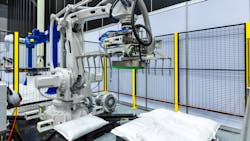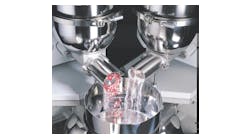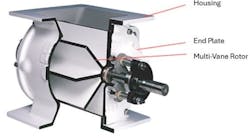A variety of machines are needed to handle bulk solids and powders, including baggers, fillers, conveyors, quality-control systems and processing equipment such as mixers and grinders.
Bulk solids handling and processing is a growing market. The value of dry/powder/solid product filling machinery shipments was estimated at $613.7 million in 2021, up 10.1% from 2020, according to the “2022 State of the Industry, U.S. Packaging Machinery Report,”1 published in July 2022 by PMMI Business Intelligence, a division of PMMI, The Association for Packaging and Processing Technologies. The food industry was the largest user of this type of equipment in 2021, accounting for 68.6% of total revenue. This was followed by the household, industrial and agricultural chemicals segment at 13.0% and pharma at 6.0%.
Automation continues to be a major driver of machinery purchases. In fact, automation is the second most important operational priority (after workforce) cited by consumer packaged goods (CPG) companies participating in PMMI’s Top to Top Summit events in 2021 and 2022. Automation can offset labor constraints and play a role in improving productivity and efficiency, increasing line speed and reducing safety concerns.
Boosting productivity
A prime reason for automating powder and bulk solids processing and packaging operations is to boost productivity by reducing downtime, human error and waste; increasing precision and flexibility; improving sustainability, ergonomics, and worker safety; and moving toward the implementation of Industry 4.0.
A variety of tactics can be used to increase productivity. “Shaping the Future of Packaging Operations,”2 a report developed from PMMI’s 2022 Top to Top Summit, reveals how CPG firms boost productivity:
- 60% use data collection to show the long-term picture for operational improvement;
- 57% adopt automation to reduce labor needs;
- 44% integrate cameras inside equipment to detect problems;
- 38% use augmented reality;
- 32% incorporate YouTube videos in the human-machine interface (HMI).
With the demand for more sophisticated systems, OEMs are designing machines that can trade data with the cloud and minimize downtime. Downtime reduction strategies include better availability of parts, built-in flexibility to handle multiple sizes and packaging formats, automated feeding and toolless disassembly. Enhanced HMIs offer step-by-step changeover and maintenance instructions.
OEMs serving the powder and bulk solids sector also are bolstering service offerings with more operator-accessible training modules and secure remote diagnostics, often supported by augmented reality and virtual reality. Advanced controllers and a network of sensors monitor material levels in hoppers, conveyors and vessels to minimize human error and maximize efficiency. Conveyors and other equipment can be designed to capture excess, off-spec, and waste material. This cuts costs, prevents product contamination and enhances operator safety and working conditions by preventing the release of dust into the environment.
Clean-in-place (CIP) designs also help boost productivity and provide a safer working environment. Efficient cleaning is vitally important when changing over ingredients, particularly if allergens are involved, and plays an essential role in maximizing uptime, especially if CIP cycles can be scheduled when the line is down anyway, e.g., at night. Automating the process saves time, frees personnel from a difficult manual task and limits the involvement of operators on the line, thereby meeting the highest hygiene standards.
The latest bagging machine designs for powders and bulk solids minimize operator interventions and downtime by automating and simplifying bag and product infeeds and automatically adjusting for new bag sizes. Other in-demand features include modular design and the flexibility to integrate easily with upstream and downstream equipment, as well as with coding systems. State-of-the-art baggers also offer an array of optional functions such as zipper opening, hang hole punching, desiccant delivery, gas flushing and contents settling.
A place for robotics
Increasingly, automated guided vehicles, industrial robots, collaborative robots and mobile robots, supported by artificial intelligence and advanced vision technology, serve as primary tools in automating operations, according to “The Future of Automation in Packaging and Processing,”3 another recent report from PMMI. With powdery and bulk solid products, packaging, especially the bulk-bag format, can be heavy and unwieldy to handle. Robotic systems can do the heavy lifting and moving, keep up with production speeds and offer the flexibility needed to minimize the downtime associated with today’s shorter runs and frequent changeovers. Models can be tailored to any environment and meet hygienic or explosion-safe requirements.
A range of automation tools, including robots, cobots, sensors and software, as well as equipment dedicated to handling powder and bulk solids such as baggers, bag dumping stations, conveyors and mixers will be on display at PACK EXPO Las Vegas (Sept. 11–13, 2023, Las Vegas Convention Center). Keeping pace with industry growth, PACK EXPO Las Vegas will be the most comprehensive packaging and processing show in North America in 2023. On track to be the largest and broadest edition of this trade show since its inception, PACK EXPO Las Vegas will showcase solutions from over 2,000 suppliers. From engaging with colleagues and hearing from industry experts to witnessing materials, technologies, and machinery in action, attending PACK EXPO Las Vegas is the most effective way to explore packaging and processing solutions for every kind of product, entire production lines and even the supply chain. To register and learn more, visit packexpolasvegas.com.
1. https://www.pmmi.org/report/state-industry-2022
2. https://www.pmmi.org/report/2022-shaping-future-packaging-operations
3. https://www.pmmi.org/report/2022-future-automation-packaging-and-processing
Jorge Izquierdo is vice president of market development for PMMI, The Association for Packaging and Processing Technologies. He oversees PMMI’s market development plans, research and programs for strengthening the competitiveness of North American suppliers of packaging and processing equipment.
PMMI
www.pmmi.org


